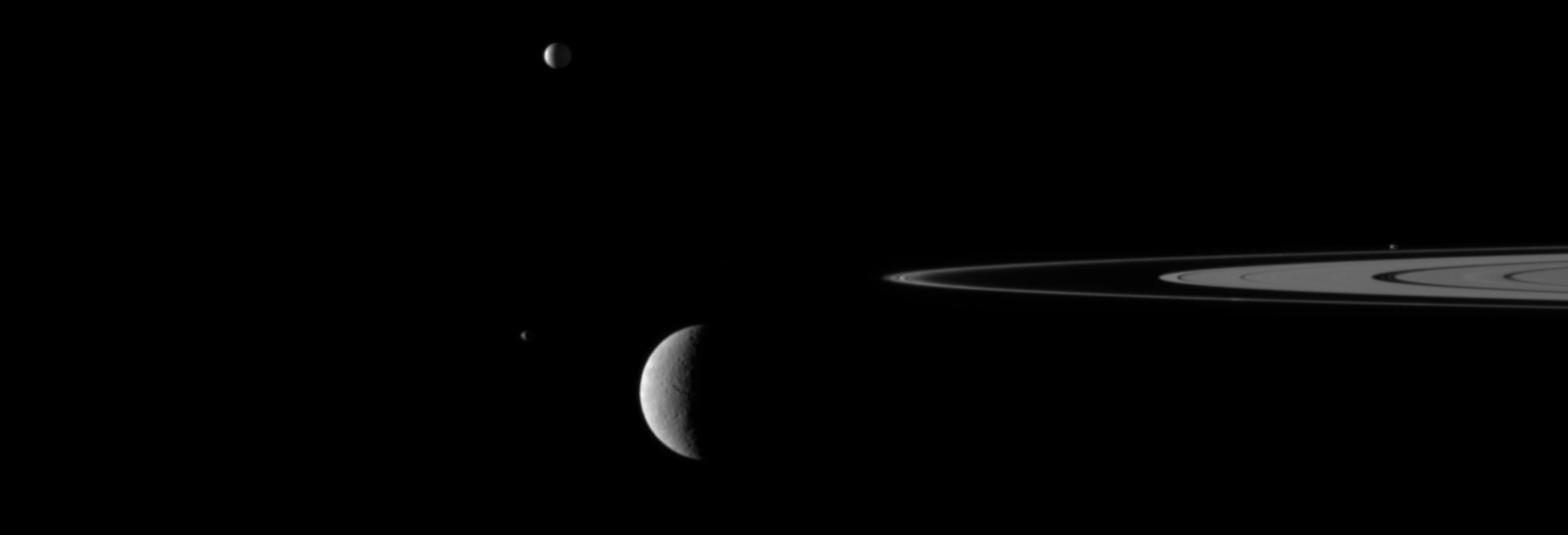Moon Jumble

| PIA Number | PIA11693 |
|---|---|
| Language |
|
+ Viewing options
A gaggle of moons parades around Saturn's rings in this movie from NASA's Cassini spacecraft, featuring Rhea and three other moons.
This sight may at first appear confusing, with four moons moving to and fro in their orbits. But imaging sequences like this, in which one moon passes close to or in front of another, actually help scientists refine their understanding of the orbits of Saturn's moons. The movie is a concatenation of 12 still images obtained over a span of 19 minutes. The images were re-projected to a uniform view and computer interpolation was used to smooth the moons' motion between the frames.
At the start of the movie, Rhea (1,528 kilometers, 949 miles across) is at the lower left and moving to the right, as seen by Cassini. Janus (179 kilometers, 111 miles across) is near Rhea in the lower left. Mimas (396 kilometers, 246 miles across) is near the center top and is moving left. About one-third of the way through the movie, Pandora (81 kilometers, 50 miles across) enters the frame on the right, orbiting just beyond Saturn's rings.
Mimas is farthest from Cassini at a distance of approximately 2.5 million kilometers (1.6 million miles). Rhea is closest to the spacecraft at a distance of approximately 1.9 million kilometers (1.2 million miles). Mimas travels at an average speed of 14 kilometers per second (31,000 mph). Janus' and Pandora's average speeds are each about 16 kilometers per second (36,000 mph). Rhea is the slowest of this quartet, traveling at an average speed of about 8 kilometers per second (18,000 mph).
(For other movies like this one, see Before a Veiled Rhea and Catching Big Sister.)
The images were obtained in visible light with Cassini's narrow-angle camera on Nov. 8, 2009. The view was acquired at a Sun-Rhea-spacecraft, or phase, angle of 105 degrees. Scale on Rhea is 11 kilometers (7 miles) per pixel.
The Cassini-Huygens mission is a cooperative project of NASA, the European Space Agency and the Italian Space Agency. The Jet Propulsion Laboratory, a division of the California Institute of Technology in Pasadena, manages the mission for NASA's Science Mission Directorate, Washington, D.C. The Cassini orbiter and its two onboard cameras were designed, developed and assembled at JPL. The imaging operations center is based at the Space Science Institute in Boulder, Colo.
For more information about the Cassini-Huygens mission visit http://saturn.jpl.nasa.gov . The Cassini imaging team homepage is at http://ciclops.org .
Credit: NASA/JPL/Space Science Institute
